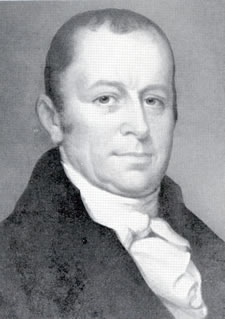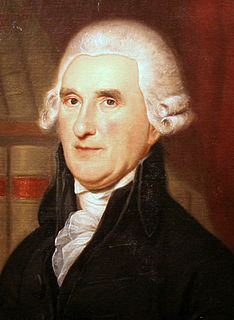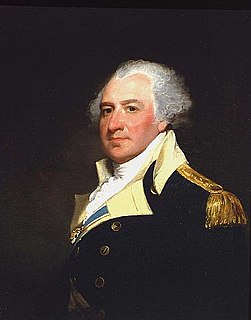
The Federalist Party, referred to as the Pro-Administration party until the 3rd United States Congress as opposed to their opponents in the Anti-Administration party, was the first American political party. It existed from the early 1790s to the 1820s, with their last presidential candidate being fielded in 1816. They appealed to business and to conservatives who favored banks, national over state government, manufacturing, and preferred Britain and opposed the French Revolution.

The United States presidential election of 1812, the seventh quadrennial American presidential election, was held from Friday, October 30, 1812 to Wednesday, December 2, 1812. Taking place in the shadow of the War of 1812, incumbent Democratic-Republican President James Madison defeated DeWitt Clinton, who drew support from dissident Democratic-Republicans in the North as well as Federalists. It was the first presidential election to be held during a major war involving the United States.

The United States presidential election of 1816 was the eighth quadrennial presidential election. It was held from Friday, November 1 to Wednesday, December 4, 1816. In the first election following the end of the War of 1812, Democratic-Republican candidate James Monroe defeated Federalist Rufus King. The election was the last in which the Federalist Party fielded a presidential candidate.
James Sykes was an American physician and politician from Dover, in Kent County, Delaware. He was a member of the Federalist Party, who served in the Delaware General Assembly and as Governor of Delaware.

Daniel Rodney was an American merchant and politician from Lewes in Sussex County, Delaware. He was a member of the Federalist Party, and later the National Republican Party, who served as Governor of Delaware, U. S. Representative from Delaware and U.S. Senator from Delaware.

Charles Polk Jr. was an American farmer and politician from Big Stone Beach, in Milford Hundred, Kent County, Delaware. He was a member of the Federalist Party, and later the Whig Party, who served in the Delaware General Assembly and twice as Governor of Delaware.

Levin Winder in Baltimore, Maryland. During the Revolutionary War, he was appointed major of the 4th Maryland Regiment, finally attaining the rank of lieutenant colonel at war's end. After the war, he served with the Maryland Militia at the rank of brigadier general.
The following table indicates the party of elected officials in the U.S. state of New Jersey:
The United States Senate elections of 1794 and 1795 were elections that had the formation of organized political parties in the United States, with the Federalist Party emerging from the Pro Administration coalition, and the Democratic-Republican Party emerging from the Anti-Administration coalition.

The Pennsylvania gubernatorial election of 1799 was between two candidates. Incumbent governor Thomas Mifflin was not running. The race was between Federalist U.S. Senator James Ross and Democratic-Republican Thomas McKean. The retired Chief Justice of the Pennsylvania Supreme Court, McKean was a Federalist and a Mifflin ally, as both supported strong state executive power but rejected the domestic policies of the national government.
Elections to the United States House of Representatives in Pennsylvania were held October 13, 1812 for the 13th Congress.

The 37th New York State Legislature, consisting of the New York State Senate and the New York State Assembly, met from January 25 to April 15, 1814, during the seventh year of Daniel D. Tompkins's governorship, in Albany.

The Pennsylvania gubernatorial election of 1823 occurred on November 4, 1823. Incumbent Federalist governor, Joseph Hiester, did not seek re-election. The Democratic candidate, John Andrew Shulze, defeated Federalist candidate Andrew Gregg.

The Pennsylvania gubernatorial election of 1808 occurred on November 8, 1808. Incumbent governor Thomas McKean, a former Democratic Republican who had faced impeachment by members of his own party during the prior term, was not a candidate. Democratic-Republican candidate Simon Snyder, former Speaker of the Pennsylvania House of Representatives defeated Federalist candidate and former U.S. Senator James Ross to become Governor of Pennsylvania. Snyder, with the aid of a supportive press, campaigned as a "New School Democrat" and attempted to ally himself with James Madison. He painted the former McKean administration as elitist and advocated for popular democracy, governmental intervention in the economy, and infrastructural support for Western Pennsylvania counties.

The Pennsylvania gubernatorial election of 1805 occurred on November 5, 1805. Incumbent governor Thomas McKean won a contentious election over the endorsed Democratic-Republican candidate, Speaker of the Pennsylvania House of Representatives Simon Snyder.

The Pennsylvania gubernatorial election of 1790 was the first gubernatorial election after the establishment of the Commonwealth of Pennsylvania as a U.S. state. Thomas Mifflin, the incumbent President of the Supreme Executive Council of the Commonwealth of Pennsylvania was elected as the first Governor of Pennsylvania. He defeated Federalist candidate Arthur St. Clair, former Revolutionary War general and President of the Continental Congress, by a wide margin.

The 1812 United States presidential election in New York took place between October 30 and December 2, 1812, as part of the 1812 United States presidential election. The state legislature chose 29 representatives, or electors to the Electoral College, who voted for President and Vice President.
















